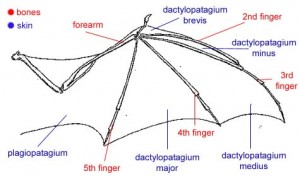Bats are the only mammals which have attained powered, flapping flights. Though bats fly, their anatomy are more closely related to humans than to birds. To be able to understand how bats fly, we must first consider the anatomy of their wings.
Bat wings are highly articulated, with more than two dozen independent joints and a thin flexible membrane covering them. Their wings are similar in structure to the human arm and hand as shown in the picture.

The bones of the hand and the four fingers are greatly elongated, light and slender to provide support and to manipulate the wing membrane which is called the patagium. The second digit, the proximal parts of the third digit, and the dactylopatagium medius compose the leading edge of the wind which is usually stiff while the third finger forms the wing tip. As for the trailing edge of the wing, it is unsupported. This set up of the wings serves as a sort of thin aerofoil with very high camber, allowing the bat to fly well under low-speed, high-lift conditions.
Thus, the patagium, which can only withstand tensile loads, consists of two thin layers of skin with high density nerves, tendons and blood vessels. The elastic fibers within the patagium increases flexibility and may store energy. An interesting fact about the patagium is that it is free of fur and scientists believe that this adaptation is to facilitate airflow.
Bat flight is considered to be one of the most complex forms of locomotion, involving interplay of a highly jointed wing skeleton and a extremely flexible membrane. Bats have unique muscles in the patagium, chest and back to power the wing during flight.
To accurately track the position and shape of bones throughout the wing stroke, researchers have placed reflective markers on joints, along the bones and at key points on the wing membrane.
Unlike birds and insects which can fold and rotate their wings during flight, bats have many more options. Their flexible skin can catch the air and generate lift or reduce drag in many different ways. During the straightforward flight, the wing is mostly extended for the down stroke, but the wing surface curves much more than a bird’s does-giving bats greater lift for less energy. During the up stroke, the bats fold the wings much closer to their bodies than other flying animals, potentially reducing the drag they experience. The wing’s extraordinary flexibility also allows the animals to make 180-degree turns in a distance of less than half a wingspan. This flexibility may be fundamental to chiroptean flight, allowing enhanced lift generation along with weight reduction. During flapping, the wings pushes against the air rowing the bat through the air. Forward movement is generated because the animal changes the angle at which the wings pass through the air, and the shape of it wings, on the up and down strokes. Thus the wing is broad against the air on the down stroke but tilted to slide through it with the minimum of resistance on the up stroke.
According to observations done, the aerodynamics of the bat’s strokes are quite different from those of birds and insects. During the down stroke, the vortex which generates much more of the lift in flapping-wing flight, closely tracks the animal’s wingtip. In the up stroke, the vortex seems to be shed from another location entirely, perhaps from the animal’s wrist joint.
This unusual pattern most likely results from the tremendous flexibility and articulation of the bat’s wings, but it also seems to contribute to a substantial savings in the energy the animal expends.
Throughout the experiments done to decipher the flight mechanism of bats, researchers have also noticed distinct differences between bats and birds. Instead of feathers projecting back from lightweight, fused arm and hand bones,bats have flexible, elastic membranes that stretch between specially extended, slender bones of the hand. Also , bat’s bones and wing membrane both change shape with every wing beat, flexing in response to the balance forces applied by the muscles and competing forces due to the air motion around them.
Furthermore, unlike bird wings, bat wings membrane must be kept under tension or else it will flap uselessly. As such, there are limits to how much the wing can be folded during flight. Finally, during upstroke, birds feather their wings but bats must do something different and eventually they have developed a twisting wing path that increases the lift during the upstroke.
Finally, one important point about the wings of bats is that they are not designed for take off and in order to take off, they have to fall from a high location. This feature of bat wings might be the reason why bats sleep upside down. To be able to sleep upside down all day without using any extra energy, bats have developed a clamp mechanism in their hind claws which is based on gravity.
References:
3 Comments
Lorena Barba posted on October 17, 2011 at 9:08 pm
Ah! That’s why they sleep hanging: they can’t take off so they have to jump! So what happens to a bat that is simply placed on the ground? It can’t fly?
Jean-Marc Tsang posted on October 17, 2011 at 9:27 pm
Yeah it can’t fly. It need to climb to a higher position using its claws and then jump off. They don’t gives a reason but I think it is because since their membrane must be in constant tension for it to fly, when it lands it cannot put its membrane again under tension by itself.
Lorena Barba posted on October 18, 2011 at 2:08 pm
Oh that is so sad, poor little bat. I will investigate a bit more! But this makes me think of the colugos and how they jump to glide.